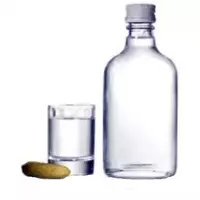Moonshine

We think that in the wide expanses of the modern Russian Federation, and in other states that were previously part of the USSR, there will be no person who has not heard the word moonshine at least once in his life. Moonshine is an integral part of not only Slavic and Russian culture and tradition. Many countries have their own authentic moonshine drinks and even methods of producing a strong alcoholic drink.
Composition of moonshine
The composition of moonshine primarily depends on the availability of raw materials in a particular region. Depending on the original ingredients, there are such types of moonshine as: cereal, fruit or fruit, beet, as well as potato. In addition to the main ingredient from which braga is made, moonshine includes sugar, water and candied starch.
Types of moonshine
In the world drinking tradition, the following types of moonshine exist: moonshine is American moonshine, palinka is Hungarian, chicha casera is produced in Latin America, German moonshine is called Schwarzgebranntes. Poles have long brewed Bimber or Samogon, other Eastern Slavs Belarusians prepare a harelka, and Ukrainians cook a throat. Sophisticated French came up with their own recipe for moonshine called tord-boyaux, Latvians call a strong drink - kandža, and Lithuanians - samogonas.
Over its centuries-old history, the strong drink has been made from various raw materials and in various ways. Until now, the so-called "homemade or artisanal" moonshine is popular, such a strong drink is made on a homemade moonshine apparatus. There is also an industrial production of alcoholic beverage. However, it is believed that such a drink cannot be compared in quality and taste with artisanal analogues, especially since there is no benefit from moonshine brewed and spilled at the plant.
Benefits of moonshine
Many connoisseurs of the drink say that there is a real benefit from moonshine, which is produced using old family recipes. Whether a 95-degree alcoholic beverage can have tangible beneficial properties or the harm of moonshine is more obvious. Just 50 grams of pepper moonshine is thought to help avoid a cold. In folk medicine, there are recipes for moonshine rubbing and compresses that help with colds, high temperatures, joint pain.
The harm of moonshine
Moonshine is made by distillation of braga, the result is raw alcohol, the minimum strength of which is 60 degrees. In such a first moonshine, a huge amount of side substances are concentrated. For example, fusel oils or methanol, such substances adversely affect the human body. Therefore, it is customary to further clean and filter the first moonshine before eating.
Often artisanal manufacturers miss the moment of filtration and purification of the final product, so it is not uncommon for fatal cases after drinking crude alcohol. The harm from moonshine, which is produced in violation of the process of making and cleaning alcoholic products, can provoke serious consequences for the health of most people.
For this reason, in a number of countries at the legislative level, a ban was introduced on moonshine, on the sale of home or handicraft products. The interesting thing is that there is an incredible amount of legal moonshine in the world. For example, the famous calvados cider, gin, chacha, rakiya, brandy, rum and grappa are produced using the same technology as moonshine.
moonshine 235 kCal
Energy value of moonshine (Ratio of proteins, fats, carbohydrates - ju):
Proteins: 0.1 g (~ 0 kCal)
Fats: 0.1 g (~ 1 kCal)
Carbohydrates: 0.4 g (~ 2 kCal)
Energy ratio (bj | y): 0% | 0% | 1%
 Español
Español Français
Français Português
Português Русский
Русский 简体中文
简体中文 繁體中文
繁體中文 日本語
日本語 한국어
한국어 العربية
العربية Türkçe
Türkçe Қазақ
Қазақ Deutsch
Deutsch Italiano
Italiano Українська
Українська
